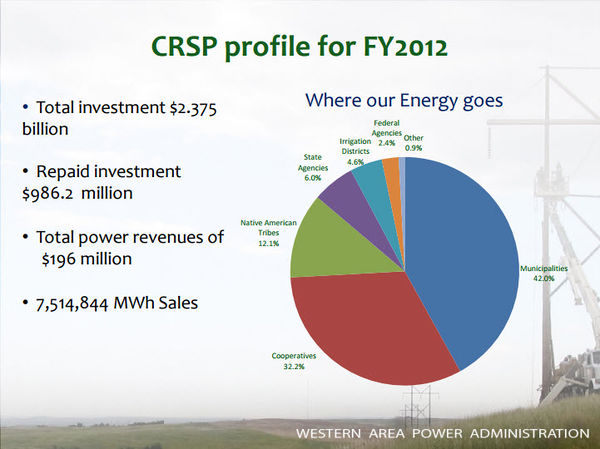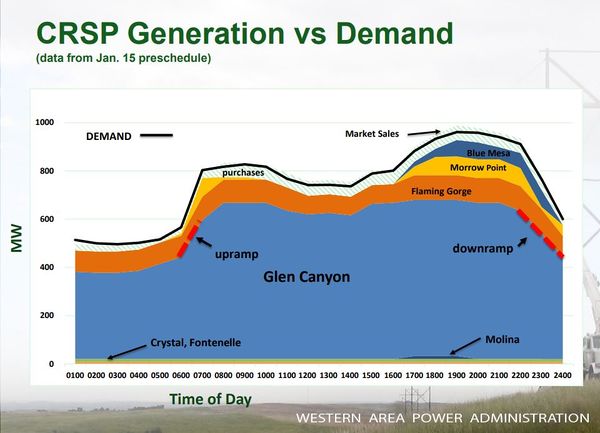Difference between revisions of "HYDROPOWER"
Cellsworth (Talk | contribs) |
Cellsworth (Talk | contribs) |
||
| (2 intermediate revisions by the same user not shown) | |||
| Line 68: | Line 68: | ||
|style="color:#000;"| | |style="color:#000;"| | ||
| − | CRSPA Section 1 (43 U.S.C. § 620) defines the purposes of the CRSP, which are (numbers added): In order to initiate the comprehensive development of the water resources of the Upper Colorado River Basin, for the purposes, among others, of | + | CRSPA Section 1 (43 U.S.C. § 620) defines the purposes of the CRSP, which are (numbers added): In order to initiate the comprehensive development of the water resources of the Upper Colorado River Basin, for the purposes, among others, of |
| + | #regulating the flow of the Colorado River, | ||
| + | #toring water for beneficial consumptive use, making it possible for the States of the Upper Basin to utilize, consistently with the provisions of the Colorado River Compact, the apportionments made to and among them in the Colorado River Compact and the Upper Colorado River Basin Compact, respectively, providing for the | ||
| + | #reclamation of arid and semiarid land, | ||
| + | #for the control of floods, and for the | ||
| + | #generation of hydroelectric power, as an incident of the foregoing purposes. | ||
Note the use of the word INCIDENT. It is not INCIDENTAL. It is not secondary, lesser, subservient, nonexistent, or any other descriptor. It is RELATED TO the foregoing purposes. Section 1 of the Act also contains another reference to hydropower by its authorization “to construct, operate and maintain….dams, reservoirs, powerplants, transmission facilities and appurtenant works.” | Note the use of the word INCIDENT. It is not INCIDENTAL. It is not secondary, lesser, subservient, nonexistent, or any other descriptor. It is RELATED TO the foregoing purposes. Section 1 of the Act also contains another reference to hydropower by its authorization “to construct, operate and maintain….dams, reservoirs, powerplants, transmission facilities and appurtenant works.” | ||
| − | The protection and clarity about hydropower isn’t limited to these two references. Later in the Act, section 7 (43 U.S.C. § 620f) requires that the | + | The protection and clarity about hydropower isn’t limited to these two references. Later in the Act, section 7 (43 U.S.C. § 620f) requires that the Glen Canyon Dam hydropower plants “be operated in conjunction with other Federal powerplants, present and potential, so as to produce the greatest practicable amount of power and energy that can be sold at firm power and energy rates”. Note the Act does not direct Federal power agencies to maximize revenues. [[Media:Hydropower_Foundation_AMP_230707_final.pdf|(1)]] |
|- | |- | ||
| Line 89: | Line 94: | ||
The key words are fully consistent AND SUBJECT TO. Some may argue that only water is addressed in 1802(b). CRSPA Sections 1 and 7 explicitly create the inextricable link by law between water and hydropower. | The key words are fully consistent AND SUBJECT TO. Some may argue that only water is addressed in 1802(b). CRSPA Sections 1 and 7 explicitly create the inextricable link by law between water and hydropower. | ||
| − | The “consistent with and subject to” was also clarified in the early days of the Glen Canyon Dam Adaptive Management Program (GCDAMP). | + | The “consistent with and subject to” was also clarified in the early days of the Glen Canyon Dam Adaptive Management Program (GCDAMP). [[Media:Hydropower_Foundation_AMP_230707_final.pdf|(1)]] |
|- | |- | ||
| Line 102: | Line 107: | ||
In other words, the GCPA did not modify the authorized purposes of the CRSPA, and the GCDAMP derives its authority from the GCPA. The United States cited to this history in its GCT v. US Memo in Opposition Dkt. 135 at p. 38, fn22. | In other words, the GCPA did not modify the authorized purposes of the CRSPA, and the GCDAMP derives its authority from the GCPA. The United States cited to this history in its GCT v. US Memo in Opposition Dkt. 135 at p. 38, fn22. | ||
| − | As a sidenote, section 102 of the 1968 Colorado River Basin Project Act (43 U.S.C. § 1501(a) also uses “incident” in the same way as CRSPA. This Act “added in” recreation and improving conditions for fish and wildlife. | + | As a sidenote, section 102 of the 1968 Colorado River Basin Project Act (43 U.S.C. § 1501(a) also uses “incident” in the same way as CRSPA. This Act “added in” recreation and improving conditions for fish and wildlife. [[Media:Hydropower_Foundation_AMP_230707_final.pdf|(1)]] |
|- | |- | ||
| Line 115: | Line 120: | ||
In 2012, following an extensive facilitated process, the Secretary of the Interior, Ken Salazar, supported the “DFC Report” (Desired Future Conditions), which was the AMWG’s consensus view of what goals the Adaptive Management Program should strive for. Page 1 of the “DFC Report” cites sections 1802(a) and 1802(b) of the GCPA, along with Judge Campbell’s statement (above). The anticipated next steps beyond the DFCs were going to be quantifying those that hadn’t been quantified (hydropower had established metrics), through the LTEMP. As we see today, the AMP is still struggling with metrics for some of the resource goals. | In 2012, following an extensive facilitated process, the Secretary of the Interior, Ken Salazar, supported the “DFC Report” (Desired Future Conditions), which was the AMWG’s consensus view of what goals the Adaptive Management Program should strive for. Page 1 of the “DFC Report” cites sections 1802(a) and 1802(b) of the GCPA, along with Judge Campbell’s statement (above). The anticipated next steps beyond the DFCs were going to be quantifying those that hadn’t been quantified (hydropower had established metrics), through the LTEMP. As we see today, the AMP is still struggling with metrics for some of the resource goals. | ||
| − | DFCs were the precursors to the objectives in LTEMP. Power was a standalone DFC, later morphing into the LTEMP objective to “Maintain or increase Glen Canyon Dam electric energy generation, load following capability, and ramp rate capability, and minimize emissions and costs to the greatest extent practicable, consistent with improvement and long-term sustainability of downstream resources.” | + | DFCs were the precursors to the objectives in LTEMP. Power was a standalone DFC, later morphing into the LTEMP objective to “Maintain or increase Glen Canyon Dam electric energy generation, load following capability, and ramp rate capability, and minimize emissions and costs to the greatest extent practicable, consistent with improvement and long-term sustainability of downstream resources.” [[Media:Hydropower_Foundation_AMP_230707_final.pdf|(1)]] |
|- | |- | ||
| Line 127: | Line 132: | ||
b. Continued implementation of environmental and other programs historically funded by CRSPA revenues that are beneficial to the Colorado River system; <br> | b. Continued implementation of environmental and other programs historically funded by CRSPA revenues that are beneficial to the Colorado River system; <br> | ||
c. Continued electrical service to power customers including municipalities, cooperatives, irrigation districts, federal and state agencies and Native American Tribes, and the continued functioning of the western Interconnected Bulk Electric System that extends from Mexico to Canada and from California to Kansas and Nebraska; and <br> | c. Continued electrical service to power customers including municipalities, cooperatives, irrigation districts, federal and state agencies and Native American Tribes, and the continued functioning of the western Interconnected Bulk Electric System that extends from Mexico to Canada and from California to Kansas and Nebraska; and <br> | ||
| − | d. Safety contingencies for nuclear power plant facilities within the Colorado River Basin. <br> | + | d. Safety contingencies for nuclear power plant facilities within the Colorado River Basin. [[Media:Hydropower_Foundation_AMP_230707_final.pdf|(1)]]<br> |
|- | |- | ||
| Line 200: | Line 205: | ||
*[https://www.usbr.gov/power/index.html U.S. Bureau of Reclamation (USBR) Power Office] | *[https://www.usbr.gov/power/index.html U.S. Bureau of Reclamation (USBR) Power Office] | ||
*[https://gcdamp.com/index.php/GCDAMP_SEAHG_Page SocioEconomic Ad Hoc Group (SEAHG) page] | *[https://gcdamp.com/index.php/GCDAMP_SEAHG_Page SocioEconomic Ad Hoc Group (SEAHG) page] | ||
| + | *[[Media:Hydropower_Foundation_AMP_230707_final.pdf|Hydropower and the Glen Canyon Dam Adaptive Management Program - The Hydropower Foundation]] | ||
|- | |- | ||
| Line 240: | Line 246: | ||
*[https://www.usbr.gov/uc/progact/amp/amwg/2020-02-12-amwg-meeting/20200212-ColoradoRiverStorageProjectFundingUpdate-Presentation-508-UCRO.pdf Colorado River Storage Project Funding Update ] | *[https://www.usbr.gov/uc/progact/amp/amwg/2020-02-12-amwg-meeting/20200212-ColoradoRiverStorageProjectFundingUpdate-Presentation-508-UCRO.pdf Colorado River Storage Project Funding Update ] | ||
*[https://www.usbr.gov/uc/progact/amp/amwg/2020-02-12-amwg-meeting/20200212-GlenCanyonOverview-Presentation-508-UCRO.pdf Glen Canyon Dam Overview ] | *[https://www.usbr.gov/uc/progact/amp/amwg/2020-02-12-amwg-meeting/20200212-GlenCanyonOverview-Presentation-508-UCRO.pdf Glen Canyon Dam Overview ] | ||
| − | *[https://www.usbr.gov/uc/progact/amp/twg/2020-01-13-twg-meeting/20200113- | + | *[https://www.usbr.gov/uc/progact/amp/twg/2020-01-13-twg-meeting/20200113-AnnualReprotingMeeting-IdentifyingTotalEconomicValueHydropowerGlenCanyonDam-Presentation-508-UCRO.pdf Identifying the total economic value of hydropower at Glen Canyon Dam and implications for adaptive management ] |
'''2019''' | '''2019''' | ||
Latest revision as of 15:58, 19 December 2024
|
|
The Hydropower ResourceGlen Canyon Dam is the second highest (710 feet) concrete-arch dam in the United States, second only to Hoover Dam which stands at 726 feet. The 26.2 million acre-feet of water storage capacity in Lake Powell, created by Glen Canyon Dam, serves as a ‘bank account’ of water that is drawn on in times of drought. This stored water has made it possible to successfully weather extended dry periods by sustaining the needs of cities, industries, and agriculture throughout the West. Hydroelectric power produced by the dam’s eight generators helps meet the electrical needs of the West’s rapidly growing population. With a total capacity of 1,320 megawatts, Glen Canyon Powerplant produces around five billion kilowatt-hours of hydroelectric power annually which is distributed by the Western Area Power Administration to Wyoming, Utah, Colorado, New Mexico, Arizona, Nevada, and Nebraska. In addition, revenues from production of hydropower help fund many important environmental programs associated with Glen and Grand canyons. The designation of Glen Canyon National Recreation Area in 1972, underscores the value and importance of the recreation benefits associated with Lake Powell and the Colorado River downstream of the dam. The GCNRA is managed by the National Park Service. Glen Canyon Dam is the key water storage unit of the Colorado River Storage Project, one of the most complex and extensive river resource developments in the world. Without it, development of the Upper Colorado River Basin states’ portion of the Colorado River would not have been possible. [1] LTEMP Resource Goal for the Hydropower ResourceMaintain or increase Glen Canyon Dam electric energy generation, load following capability, and ramp rate capability, and minimize emissions and costs to the greatest extent practicable, consistent with improvement and long-term sustainability of downstream resources. Desired Future Condition for the Hydropower Resource• Glen Canyon Dam capacity and energy generation is maintained and increased, so as to produce the greatest practicable amount of power and energy, consistent with the other DFCs. |
| --- |
Hydropower - Online Training |
--- |
|---|
|







